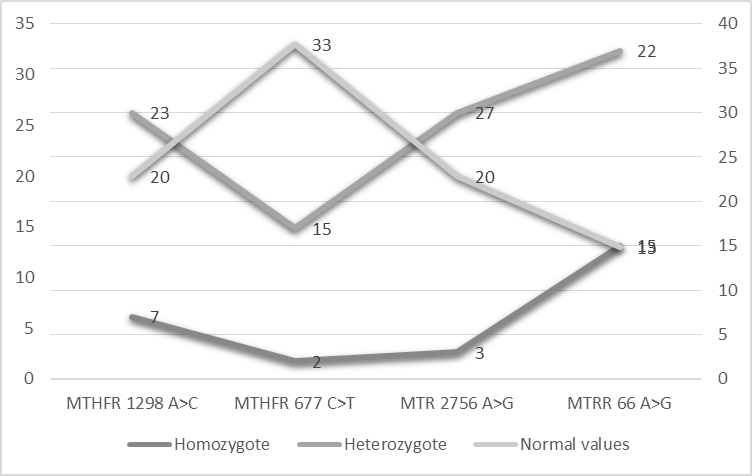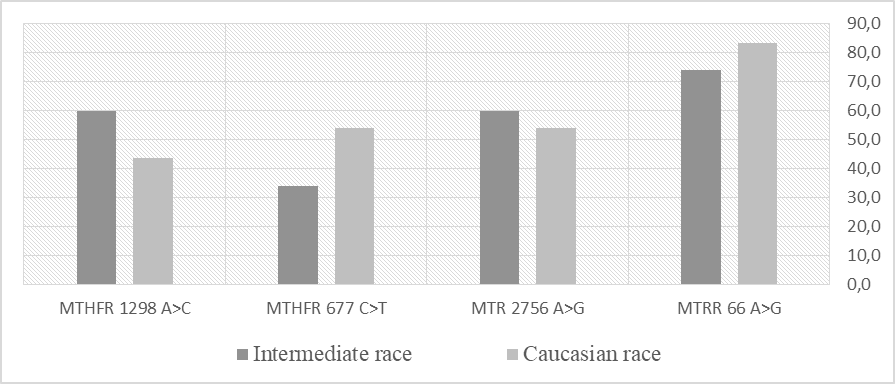Полиморфизм генов фолатного цикла (MTHFR, MTR и MTRR) у представителей разных этнических групп, входящих в состав овощеводческих бригад
Полиморфизм генов фолатного цикла (MTHFR, MTR и MTRR) у представителей разных этнических групп, входящих в состав овощеводческих бригад
Аннотация
Обоснование: Фолатный цикл – неотъемлемая часть метаболизма человека. Носительство аллельных генов фолатного цикла (MTHFR, MTRR, MTR), изменяющих функциональные характеристики системы ферментов их количество и стабильность, может нарушать баланс в метаболизме одноуглеродных групп и лежать в основе генетической предрасположенности к различного рода патологиям. В связи с этим, анализ распределения мутаций генов фолатного цикла в различных этнических группах представляет несомненный прогностический интерес для профилактики неотложных состояний у рабочих овощеводческих бригад при сельскохозяйственных работах.
Целью исследования является изучение полиморфизма генов фолатного цикла MTHFR, MTR и MTRR у представителей различных этнических групп, входящих в состав овощеводческих бригад.
Материалы и методы: проводилось выделение ДНК и генотипирование ПЦР-Real-time из венозной крови испытуемых, разделенных на группы по этническому признаку с использованием тест-системы ДНК ПРОБА-РАПИД-ГЕНЕТИКА (ДНК-технология, Россия).
Результаты: В данной работе были исследованы гены фолатного цикла у представителей европеоидной и переходной рас. В обеих популяциях наблюдалось небольшое смещение от равновесия Харди-Вайнберга, что было отражено в таких показателях, как χ2-квадрат Пирсона, p-value и коэффициент Селендера.
Заключение: Наличие гетерозиготных аллелей в популяциях, вызвавших смещение от равновесия Харди-Вайнберга, является прогностически неблагоприятным признаком, свидетельствующим о существующей предрасположенности к нарушению фолатного цикла у обследованных.
1. Introduction
Astrakhan Region is a developed agricultural area. During the period of fieldwork, seasonal workers come to the region to take part in growing and harvesting fruit and vegetables in spring and summer. Vegetable farm brigades working in the fields of the region involve representatives of different ethnic groups. From June to August, the highest registered outdoor temperatures in Astrakhan Region, which belongs to the hot climate zone, mainly range from +25оС to +38оС. In these conditions, persons with predisposition to the development of acute cardiovascular pathology are most exposed to its risk and require increased attention from healthcare professionals and preventive measures to be taken. It is known that polymorphism of folate cycle genes is one of the factors favoring such pathology.
Statistical and population analysis for studying the role of biochemical and molecular genetic factors in this regard has been conducted for some time , . To date, these studies have helped accumulate an array of clinical data which allow to differentiate an abnormal homocysteine content, folic acid deficiency, and folate cycle gene polymorphism as a separate group of factors causing various human diseases , , and , , .
Folate cycle genes include sequences that encode methylenetetrahydrofolate reductase (MTHFR), methionine synthase reductase (MTRR), and methionine synthase (MTR). Disruption of this cycle results in an increase of homocysteine levels in the blood. This can lead to vascular endothelial damage and increase the risk of cardiovascular diseases, including stroke , , , . At the same time, literature sources hardly have information on the distribution of pathogenic alleles encoding this type of pathologic changes in representatives of different ethnicities.
The study objective is to examine into the polymorphism of the folate cycle genes MTHFR, MTR and MTRR in vegetable farmworkers of different ethnicities.
2. Materials and methods
The study involved 98 women aged 18 to 45 years, working in vegetable growing brigades in Astrakhan Region. All the examinees participated voluntarily; they were informed about the genetic study and filled out the informed consent for its conduct.
All the women were divided into two groups by race:
1. Russians, who belong to the Caucasian race (48 women).
2. Kazakhs and Turkmens, who belong to the intermediate race between the Mongoloid and the Caucasoid races (50 women).
Ulnar vein blood was sampled after an overnight fast for genetic testing. DNA was isolated from the EDTA-stabilized whole blood according to the manufacturer’s instructions for the DNA isolation reagent kit PREP-RAPID-GENETICA (DNA-Technology, Russia).
Polymorphisms of the folate cycle genes – MTHFR 677 C>T, MTHFR 1298 A>C, MTR 2756 A>G, and MTRR 66 A>G – were genotyped with real-time PCR according to the instructions of the Folate Metabolism kit system (DNA-Technology, Russia). Amplification results were registered and accounted in real time with the DT-96 amplifier (DNA-Technology, Russia).
Statistical analysis was applied to identify trends and patterns in the data, to assess the quality of the data and determine its reliability. The Statistica 12 software package (StatSoft, USA) was used to analyze the results. Pearson’s χ2 test was applied to assess the significance of differences between the expected and observed distribution of genotypes between the populations; the significance level was taken at α=0.05 , .
3. Findings
At the first stage of the study, we analyzed SNP substitutions of the most common folate cycle genes: MTRR 66A>G, MTR 2756 A>G, MTR 2756 A>G, MTHFR 1298 A>C, and 677 C>T (Figure 1 and Figure 2).

Figure 1 - Distribution of SNP substitutions in the intermediate race (Kazakhs and Turkmens)

Figure 2 - Distribution of SNP substitutions in the Caucasian race (Russians)

Figure 3 - Comparison of total substitutions across all loci in the two studied groups
Among the representatives of the Caucasian race, loci A66G and C677T of the MTRR and MTHFR genes correspond to the distribution of genotypes according to the Hardy-Weinberg law, with slight deviations (Table 1). Loci A1298C and A2756G of the MTHFR and MTR genes show a statistically significant deviation from the Hardy-Weinberg equilibrium. Selender’s coefficient is also elevated – 0.18 and 0.14 for loci A1298C and A2756G, respectively, – implying an excess of heterozygotes. Locus C677T shows a negative Selender’s coefficient of -0.061, indicating a lack of heterozygous genotype in the population. A small excess of heterozygotes is observed in MTRR A66G.
Table 1 - Comparative analysis of genotype frequencies in polymorphic variants of folate cycle genes in the Caucasian race (Russians)
Locus | Genotype | N.O, % | N.E, % | χ2 d.f. = 1 | Allele frequency | Ho He | D |
С677T | CC | 45.8 | 44.4 | 0.0222 p=0.911 | C=0.667 T=0.333 | Ho=0.417 He=0.444 | -0.061 |
CT | 31.0 | 31.0 | |||||
TT | 3.5 | 3.5 | |||||
A1298C | AA | 56.2 | 59.4 | 0.394 p=0.462 | А=0.771 С=0.229 | Ho=0.417 He=0.353 | 0.18 |
AC | 41.7 | 35.4 | |||||
CC | 2.1 | 5.2 | |||||
A2756G | AA | 45.8 | 48.8 | 0.124 p=0.640 | А=0.698 G=0.302 | Ho=0.479 He=0.422 | 0.14 |
AG | 47.9 | 42.1 | |||||
GG | 6.3 | 9.1 | |||||
A66G | AA | 16.6 | 18.3 | 0.0149 p=0.906 | А=0.427 G=0.573 | Ho=0.521 He=0.489 | 0.065 |
AG | 44.8 | 49.7 | |||||
GG | 24.2 | 21.7 |
Note: N.O. is the observed frequency of genotypes; N.E. is the expected frequency of genotypes; the χ2 criterion is used to assess whether the observed genotype distribution corresponds to the expected one based on the Hardy-Weinberg equilibrium; d.f. is the number of degrees of freedom; Ho and He are the observed heterozygosity and the expected heterozygosity, respectively; D is the relative deviation of the observed heterozygosity from the expected one (Selender’s coefficient)
The distribution of genotypes of loci C677T, A1298C in the intermediate race corresponds to the Hardy-Weinberg equilibrium with slight deviations (Table 2). It is also worth noting that the distribution of genotypes in these loci can be considered ideal, since the p-value tends to unity (100%) and the χ2 criterion – to zero, which is a reliable sign of matching the Hardy-Weinberg equilibrium. However, the probability that the observed frequencies coincide with the expected ones in locus A2756G is 29%. It can be assumed that this deviation from equilibrium is due to the fact that the level of the observed heterozygosity is lower than the expected one, as reflected in a high negative Selender’s coefficient (-0.22). The reason for heterosis may be that organisms that are heterozygous for genes encoding enzymes possess two forms of the enzyme at once. Loci C677T and A1298C show a low value of Selender’s coefficient against low Pearson’s coefficient, which indicates that the observed heterozygosity is close to the expected one.
Table 2 - Comparative analysis of genotype frequencies in polymorphic variants of folate cycle genes in the intermediate race (Kazakhs and Turkmens)
Locus | Genotype | N.O, % | N.E, % | χ2 d.f. = 1 | Allele frequency | Ho He | D |
С677T | CC | 66.0 | 65.6 | 0.0131 p=0.984 | C=0.810 T=0.190 | Ho=0.300 He=0.308 | 0.026 |
CT | 30.0 | 30.8 | |||||
TT | 4.0 | 3.6 | |||||
A1298C | AA | 40.0 | 39.6 | 0.0011 p=0.996 | А=0.630 С=0.370 | Ho=0.460 He=0.466 | 0.013 |
AC | 46.0 | 46.6 | |||||
CC | 14.0 | 13.6 | |||||
A2756G | AA | 40.0 | 48.8 | 0.258 p=0.294 | А=0.670 G=0.330 | Ho=0.540 He=0.442 | -0.22 |
AG | 54.0 | 42.1 | |||||
GG | 6.0 | 9.1 | |||||
A66G | AA | 26.0 | 23.0 | 0.0438 p=0.704 | А=0.480 G=0.520 | Ho=0.440 He=0.499 | 0.12 |
AG | 44.0 | 50.0 | |||||
GG | 30.0 | 27.0 |
Note: N.O. is the observed frequency of genotypes; N.E. is the expected frequency of genotypes; the χ2 criterion is used to assess whether the observed genotype distribution corresponds to the expected one based on the Hardy-Weinberg equilibrium; d.f. is the number of degrees of freedom; Ho and He are the observed heterozygosity and expected heterozygosity, respectively; D is the relative deviation of the observed heterozygosity from the expected one (Selender’s coefficient)
Analysis of the observed and the expected genotype distributions according to the Hardy-Weinberg equilibrium revealed that loci 677C>T and 66A>G have low χ2 values in the two races, indicating little difference between the expected and the observed distributions. In contrast, loci 1298A>C and 2756A>G show a high χ2 in the Caucasian and the intermediate races, respectively (Fig. 4). These statements indicate a high percentage of mutations (SNP substitutions) in the population, which may only be increased over time, leading to an increased incidence of disease and an increased occurrence of mutant-allele homozygous organisms.

Figure 4 - χ2 value in the studied loci and populations
4. Conclusion
The study of folate cycle genes in the representatives of the Caucasian and the intermediate races revealed a deviation from the Hardy-Weinberg equilibrium, which indicates the presence of heterozygous alleles in the studied groups. This is a prognostically unfavorable sign indicating an existing predisposition to folate cycle disorder and, as a consequence, an increased concentration of homocysteine and its derivatives in blood serum, which favors endothelial damage and exposure of subendothelial matrix and smooth muscle cells with their subsequent enhanced proliferation. Along with this, homocysteine excess favors the activation of factors XII and V and the expression of tissue factor. Moreover, the release of natural inhibitors of coagulation and antiaggregants – protein C, an inhibitor of the extrinsic coagulation pathway, – is disturbed; glycosaminoglycan-dependent activation of antithrombin III is reduced; thrombomodulin activity is suppressed. These thrombophilic and atherogenic effects (participation of homocysteine in the formation of so-called “foam cells” inside the atheromatous plaque) in their totality determine chronic endothelial dysfunction and a high probability of cardiovascular pathology development. In this regard, persons with heterozygous alleles who are engaged in field physical labor in a hot climate should be under the supervision of appropriate medical specialists.
